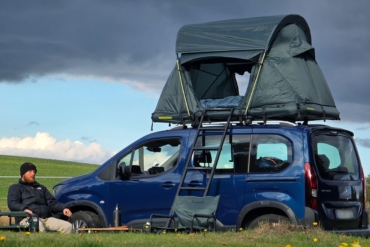Bigger than a bivy (but tighter than a traditional tent) the High Side shoots for the weight-to-space sweet spot.
I’m cold, wet, and tired. After nearly 20 miles of backpacking and bushwhacking through Rocky Mountain National Park, I’m ready to hit the hay.
My room for the night is Sierra Designs’ High-Side solo tent. It’s cozy to say the least. But the beefy pseudo-bivy, available in early 2018, packs in more versatility, space, and weight savings than I expected.
In short: The one-person High Side is made for introductory backcountry-goers or experienced thru-hikers alike. It weighs about 2 pounds and has setup options that combine function with comfort. Cost will be $280.
Sierra Designs High Side Tent Review
To start, I’m 6’3″ and not exactly narrow. In general, two-person tents fit me better than one-person shelters. So, most people don’t notice the issues I do when sleeping in a tent.

That said, the High Side eked out just enough area to give me a pleasant night’s rest. It’s by no means a bivy, but the High Side’s tapered footprint and sloping top made it a fit for lying down, not sitting.
The tent has 18.5-square-feet of space and 34 inches of shoulder room at its head.
The first thing you’ll notice is the High Side’s asymmetry. It’s a one-door tent, and Sierra Designs used that to incorporate a couple solid features. For one, it helps the tent shed water. The poles pitch the tent so that the rain fly slopes like a lean-to.
Second, it frees up options with the vestibule. With some guy lines and a nearby tree, trekking pole, or bike, the High Side lets you lift the door-side vestibule into a full awning. It won’t rival a porch, but given the High Side’s internal size, it adds welcomed sheltered sitting space for cooking or organizing gear.
Setup was straightforward. Color-coded poles guide which side is the “high side” (gold), and which is the slope (blue).
I tested a prototype model that had black webbing on the tent-floor grommets. In production Sierra Designs’ product manager told me the webbing would coordinate with the poles’ color.
Being in the rain with temps dipping to the low 40s (Fahrenheit), the big test was staying dry. There are two problems designers face when it comes to keeping wet out of their tents: preventing rainwater from getting in, and allowing warm, moist air out to prevent condensation. The latter, what I call “drip-back,” is the toughie.
The Trouble With Waterproof
Anyone who’s camped in cool weather knows the feeling of waking up to a damp sleeping bag and droplets covering their bug mesh. All this despite a properly functioning rain fly.
The problem is breathability. All that body heat and exhaling generates warm air that rises to the rain fly, cools off, and condenses. Then it drips back down. (In contrast, without a fly attached hot air can easily escape, but then you get no protection from rain.)
During my High Side tent review, I noticed a fair amount of condensation on the inside of the rain fly and a few droplets on the bug net. I wasn’t soaked, but the tent wasn’t breathable enough to prevent some drip-back.
Note, this is definitely not unique to the High Side. Both single- and double-wall tents across the industry battle against drip-back and condensation.
Casey Sumnicht, Sierra Design’s equipment product manager, noticed the droplets the next morning and took note.
“We’re still looking into fabric and ventilation options,” he told me. “We have our price point, so we’re working around that sweet spot of price, performance, and weight for the final design.”
In addition to possibly adding a push-out vent, the brand was looking at a “super-breathable” fabric for the front panel of the rain fly. He noted it’s at the far breathable end of the waterproof-breathable spectrum.
Sierra Designs 1-Person Tent Specs

What the High Side lacks in headroom, it makes up for in weight, or lack thereof. Packed up it weighs 2 lbs. 6 oz. Tent, fly, and poles alone it’s sub-2 lbs.
A note on weight measurements: Trail weight refers to the minimum weight of the tent, set up (tent, fly, poles). Packed weight includes the stuff sack, all stakes, and guy lines—the maximum weight in your pack.
Plus, the High Side comes with a compression-friendly stuff sack that cinches down to about the size of a football. This is perfect for strapping to handlebars or panniers for bike-packing or climbing where you have scant room in a pack.
Sierra Designs High Side 1P Tent
- Trail weight: 1 lb. 14oz.
- Packed weight: 2 lbs. 6 oz.
- Floor dimensions 88″ x 34″ (head) x 26″ (foot)
- Interior area: 18.5 sq. ft.
- Vestibule area: 7.7 sq. ft.
- Peak height: 32″
Final thoughts: Sierra Designs aims to get more people using legitimate gear. It has its sights on the entry- to mid-level outdoors person who wants a cut above box-store brands.
Historically, it has positioned itself as an apex brand. But the product team told me they were addressing folks who felt excluded or intimidated by technical camping and backpacking gear. The High Side is a first step at accommodating beginners through experienced campers.
At $280, this tent is an investment but won’t eat up your entire gear budget. As Sumnicht told me, he designed it “with the bike packer/solo adventurer in mind.” It’s a cozy, capable, and crafty new take on solo tent design.









